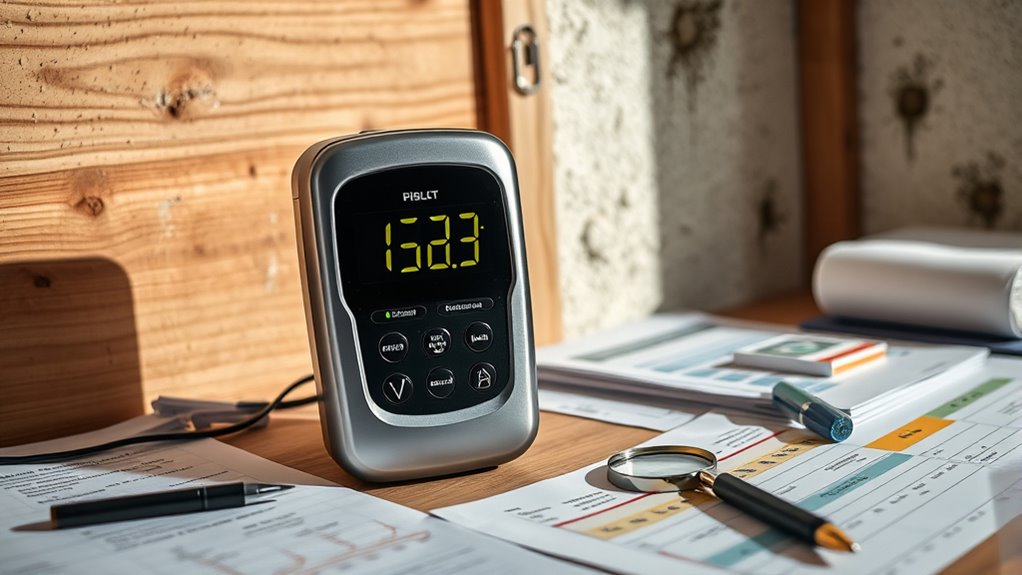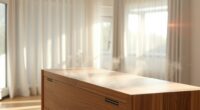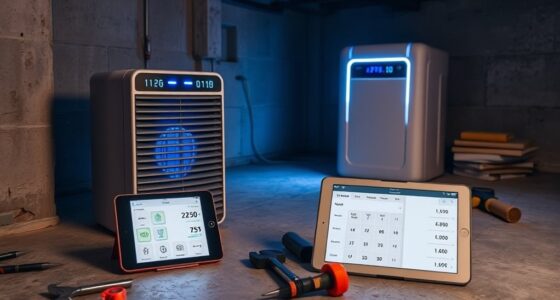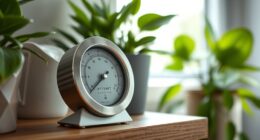To evaluate your home’s mold potential, start by monitoring moisture levels using a hygrometer in key areas like bathrooms and basements—aim for humidity below 60%. Check ventilation systems and ensure exhaust fans work properly, opening windows regularly for fresh airflow. Look for visible signs such as discolored patches or musty odors, especially around water sources. Address leaks and water damage promptly. If you keep these steps in mind, you’ll find useful tips throughout this guide to help protect your home.
Key Takeaways
- Measure indoor humidity with a hygrometer; levels above 60% increase mold risk.
- Check for visible signs of mold, water stains, or musty odors in damp areas like bathrooms and basements.
- Evaluate ventilation systems and ensure exhaust fans and windows are functioning to reduce moisture buildup.
- Inspect for leaks around plumbing fixtures, windows, and ceilings that could promote mold growth.
- Use environmental cues and moisture levels to identify high-risk areas and prioritize remediation efforts.
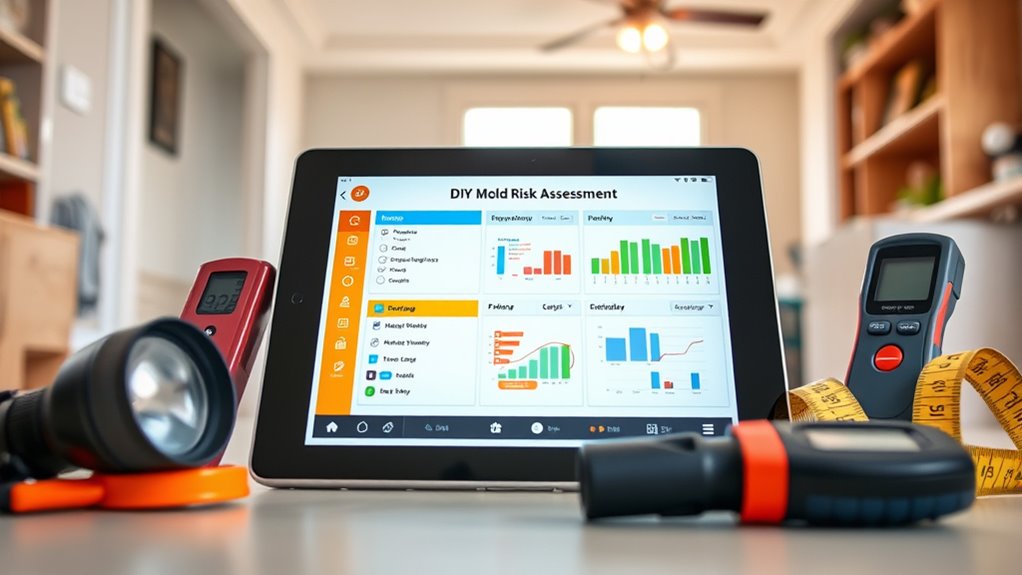
Mold can pose serious health risks and cause structural damage, but you don’t always need a professional to identify potential problems. By paying close attention to your home’s environment and performing simple checks, you can get a good sense of whether mold might be developing. One of the first steps is moisture monitoring. Mold thrives in damp, humid environments, so keeping an eye on moisture levels is essential. Use a hygrometer or moisture meter to measure humidity in different areas of your home, especially in bathrooms, basements, and kitchens. If humidity levels regularly exceed 60%, it’s a sign you need to take action. High moisture levels create the perfect conditions for mold growth, so reducing excess moisture is key to prevention.
Another critical aspect of your DIY mold risk assessment is evaluating your home’s ventilation. Poor ventilation traps moisture indoors, encouraging mold spores to settle and multiply. Check whether your bathrooms and kitchens have exhaust fans that work effectively, and consider installing or upgrading them if they’re ineffective. Opening windows regularly can also help improve air circulation, especially in areas prone to dampness. In spaces with limited airflow, consider adding vents or using dehumidifiers to pull excess moisture out of the air. Good ventilation doesn’t just reduce humidity; it also helps remove airborne mold spores, decreasing the overall mold risk.
Beyond moisture monitoring and ventilation, you should also inspect your home for visible signs of mold or water damage. Look for discolored patches on walls, ceilings, or floors, especially in areas with poor airflow or high humidity. Pay attention to musty odors, which often indicate hidden mold growth behind walls or under flooring. Check around plumbing fixtures, windows, and areas where leaks might occur. If you notice any signs, it’s a clear indicator that your home’s environment might be supporting mold growth, and you should address the underlying moisture issues promptly.
Frequently Asked Questions
How Often Should I Reassess My Home for Mold Risk?
You should reassess your home for mold risk at least every three to six months as part of your regular home maintenance. Regular checks help with mold prevention by catching moisture issues early. Pay special attention to areas prone to humidity, like bathrooms and basements. If you notice leaks or increased condensation, reassess immediately. Staying proactive helps keep mold growth under control and protects your home’s air quality.
Can This Tool Predict Future Mold Growth Accurately?
Like a crystal ball, this tool offers some insight but can’t guarantee perfect predictive accuracy. You can trust it to identify key risk factors that might signal future mold growth, yet environmental changes or unseen issues could still lead to mold development. It’s a helpful guide, but for the most reliable results, combine it with regular inspections and professional advice. Remember, prevention is better than cure!
What Should I Do if My Assessment Indicates High Risk?
If your assessment shows a high risk, you should act immediately by scheduling an urgent remediation to address potential mold issues. It’s crucial to contact a professional for a thorough inspection, as they can accurately identify the mold source and recommend the proper cleanup. Don’t delay, because mold can worsen quickly and cause health problems. Taking swift action ensures your home stays safe and mold-free.
Are There Specific Areas More Prone to Mold in All Homes?
Yes, certain areas are more prone to mold in all homes. Common problem areas include bathrooms, kitchens, basements, and around windows, as these moisture-prone zones tend to retain humidity. You should regularly check these spots for signs of mold or excess moisture, and guarantee proper ventilation. Keeping these areas dry and well-ventilated helps prevent mold growth and maintains a healthier living environment.
Does the Tool Account for Seasonal Changes Affecting Mold Risk?
Your mold risk assessment tool does consider seasonal variation and weather impact, so you’re not flying blind. It adjusts for changes like humidity spikes during rainy seasons or dry spells in summer, helping you spot mold risks that could turn your home into a mold monster. By factoring in seasonal shifts, it offers a more accurate picture of your home’s vulnerability, saving you from surprise mold invasions all year round.
Conclusion
Now that you have this DIY mold risk assessment tool, you’re practically a mold-fighting superhero ready to save your home from unseen dangers. By regularly checking for moisture problems and staying vigilant, you’ll outsmart mold before it takes hold—saving your home from destruction faster than you can say “mold invasion.” Remember, a little proactive effort now can prevent a mold disaster that’s bigger than a skyscraper later. Stay vigilant, stay safe, and keep your home mold-free!
